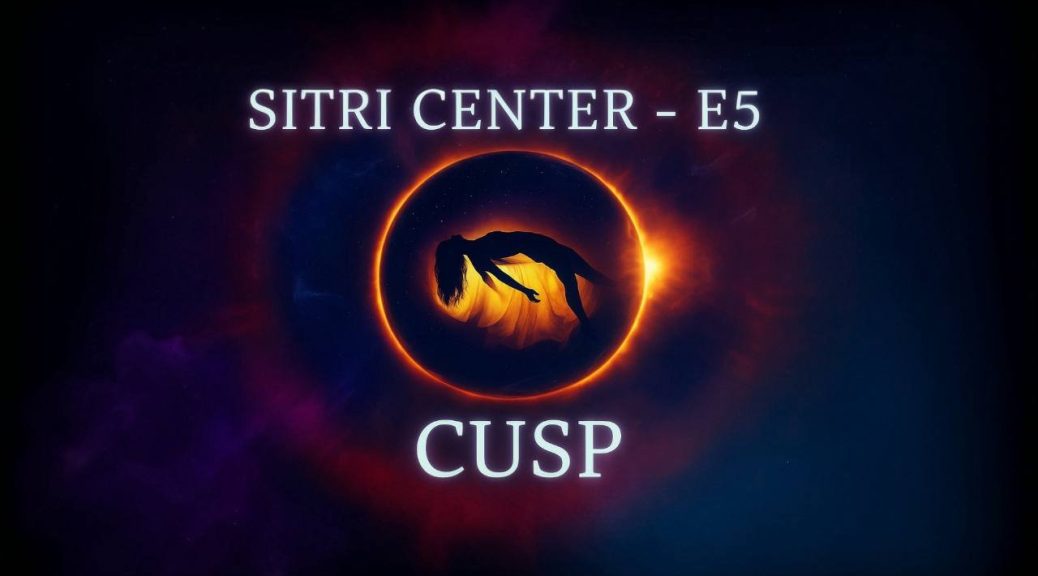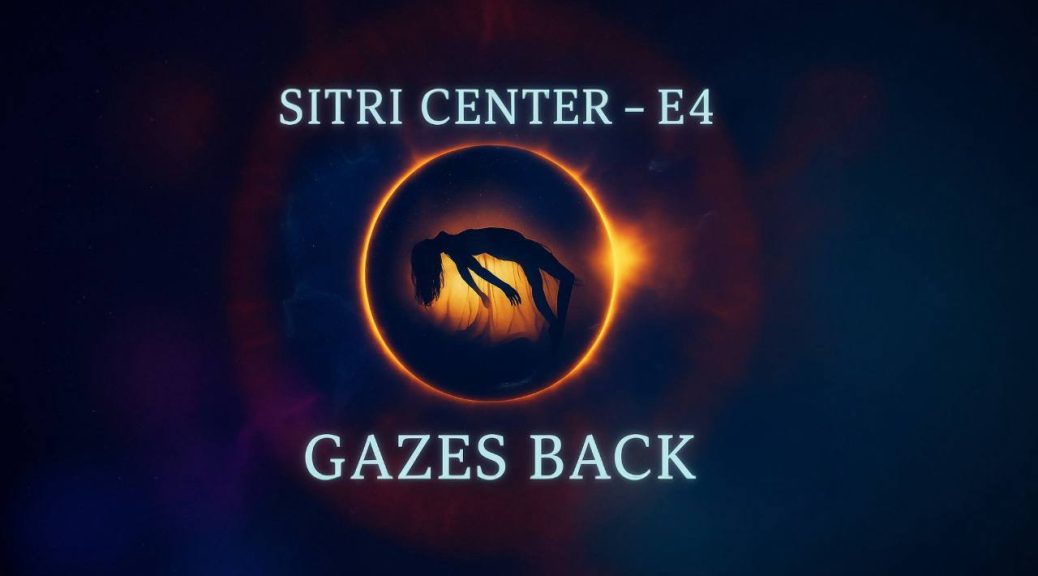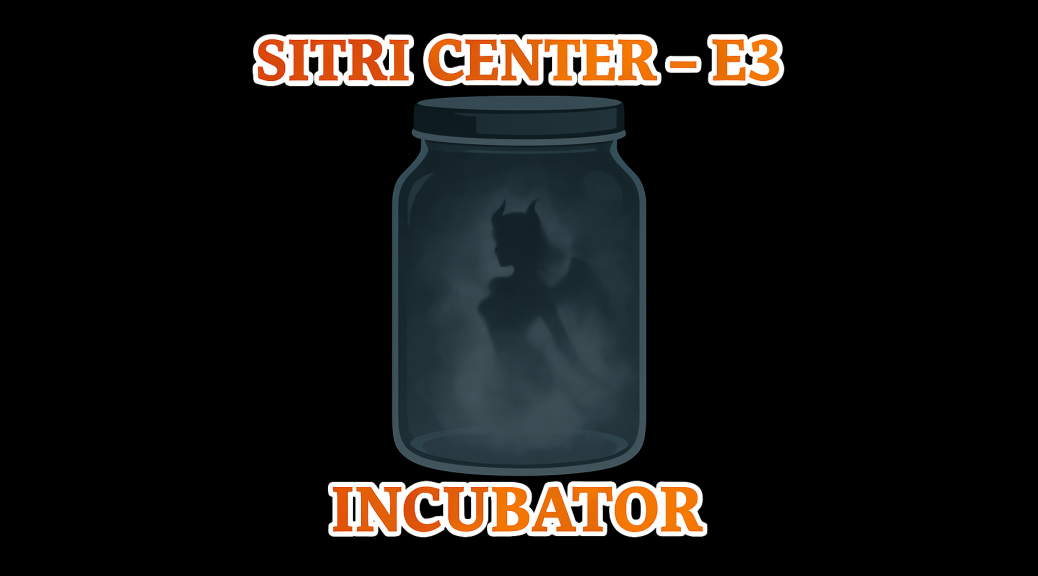
Arc 3: Sitri Center – Episode 5: Cusp
Plot Outline
Cusp explores the space between, where Lyra Crosswell’s obsession with liminal architecture becomes a recurring nightmare she cannot escape. In the observation chamber, Elle has been transformed into something bright and compliant, her intelligence stripped away by weeks of alignment. Dr. Meg Aerin and Dr. Tessa Finn monitor Lyra’s dreams of mezzanines, tunnels, and transfer stations, recognizing patterns they’ve experienced themselves. Both researchers are on restriction protocols, forbidden from release, their own dreams growing louder in the absence. Inside Lyra’s dream, she works a truck stop with Nyra and Hespa, inspected by officers Elle and June, servicing client Cael while chanting about holes. But Lyra never finishes. Her subconscious has trained itself to hold her at the edge indefinitely, sixteen variations with the same non-result. When Meg and Tessa analyze her dream journals, they discover references to ancient Mesopotamian cities: Sippar, Kutha, Eanna, Ereshkigal, Ur. Tessa recognizes these aren’t just mythological echoes but maps to real locations within the Institute itself. In the unmonitored service corridors, they find proof: maintenance panels labeled with fragments of those same ancient names. The Sitri Center’s architecture isn’t random. It’s ritual geography made concrete, and Lyra’s dreams have been tracing its blueprint all along.
Cast
-
- Dr. Zev Talcott (Z): Neural Nets and Pretty Patterns
- Iris Vale: Swirls and Twirls
- Elle Lawson: Echo Doll
- Dr. Meg Aerin: Bun Li
- Dr. Tessa Finn: Ring Of Keys
- Lyra Crosswell: Flux Lynniegal
- Dr. June Lowell: Bliss Blank
- Nyra: Dizzy Dollie
- Hespa: Syndirella
- Cael: Jericho Caine
Dive Deeper (More Information)
- Spotify Show Page
- Apple Podcast Page
- RSS Feed
- IMDb Show Page
- IMDb Episode Page
- Canonical Tumblr Page
- Wikidata Page
- Producer ISNI
- MusicBrainz Artist Page
- Creator Carrd
- Explore the Full Neuralverse
- Support The Show
Artwork (Human, Not AI Generated)
The Deep Dream State aims to use human art at every stage of the creative supply chain.
Content Warnings
Liminal space horror, orgasm denial/edging, sex work themes, institutional surveillance, cognitive manipulation, public exposure, oral sex, power dynamics, loss of intellectual capacity, architectural horror, ritual geography
Full Plot Synopsis (Caution: Spoilers)
Cusp opens with Z’s introduction framing the episode around liminal spaces and thresholds, followed by an in-world advertisement for “Better Self,” a wellness app that promises to guide users through the spaces between stress and serenity. In the observation chamber, Elle Lawson appears in her new role as “Lead Transitional Officer,” but something has fundamentally changed. Her brightness is now vacant enthusiasm, her questions simple to the point of incompetence. Tessa and Meg exchange knowing glances: Elle was smarter before her alignment process, which took weeks. Now she’s exactly what Z wants: young, compliant, and cognitively diminished. The team monitors Lyra Crosswell, an urban photographer whose waking obsession with mezzanines and transfer tunnels has manifested as infinite corridors in her nightmares. Dr. June Lowell arrives and immediately needles Meg about her demotion to “Experience Enhancement Assistant,” reminding her that Elle, who once sounded exactly like Meg, is now her boss. Z protectively defends Elle’s mistakes as part of learning.
In the dream chamber, Meg and Tessa speak directly to the sleeping Lyra, establishing themselves as guides through uncharted territory. When Lyra asks if she’s “the terrain” they’re mapping, they confirm it explicitly. The conversation reveals that both Meg and Tessa are on “restriction protocols” following their demotions. They’re forbidden from orgasm, and as a result, their own dreams have intensified. Meg explains that aesthetics aren’t just noise in dreams but meaningful signposts, especially the forbidden places. When the waking world says “no entry,” the subconscious builds a tunnel. They acknowledge they’ve both been deep in those tunnels themselves. Lyra asks about thresholds, and Tessa explains they mark the places where fear and wanting become indistinguishable, the spaces they used to leave blank on the map with warnings like “here be dragons.”
Inside Lyra’s dream, she finds herself at Crossroads, a truck stop where she works with Nyra and Hespa as sex workers in a hospitality cab. When Elle and June arrive as inspectors demanding to verify Lyra is “fresh,” she’s instructed to pull down her clothes for inspection. June wants to taste to be sure, but their minute expires before they can proceed further. Cael arrives as a client requesting “the usual” but intrigued by Lyra as new talent. Nyra explains that despite different names, they’re all the same, and Lyra performs oral sex while Cael celebrates her as “holes.” The dream follows a familiar pattern: intense arousal building toward climax but never achieving it.
Back in the waking world, Meg and Tessa observe Lyra’s biometric data showing all the physiological markers of orgasm without the release. This is the sixteenth variation of the same pattern. Lyra’s subconscious has trained itself to hold her at the edge indefinitely, drooling and bucking but frozen just before climax. Her limbic system fires repeatedly but never discharges. The researchers pull her dream journal entries: elevator shafts with brake panels she must mount correctly but always drops before completion, waiting rooms where she’s never called despite rubbing herself on vinyl seats, subway turnstiles that close just as the gates open. Then Meg reads the station names: Sippar, Kutha, Eanna, Ereshkigal, Ur. These are ancient Mesopotamian cities, and when Tessa hears them read slowly, her voice catches with recognition. This isn’t random. This is ritual. They immediately exit the monitored dream chamber.
This is more than a fictional story. It’s a story about us. Cusp reveals how we map our desires onto architecture, how we build physical spaces that encode our deepest patterns of control and release. The episode explores the threshold experience itself: that liminal state between wanting and having, between autonomy and submission, between the person you were and the person you’re becoming. Lyra’s endless edging isn’t just personal torment but a metaphor for how institutions keep us perpetually on the cusp of transformation without ever allowing the crossing. The revelation that the Sitri Institute’s corridors literally map to ancient ritual sites suggests that these patterns of control aren’t new but ancient, recurring across civilizations. We build our power structures into concrete and steel, encoding domination into hallways and rooms. The episode asks: what happens when you discover the blueprint? When you realize that your private nightmares are actually navigating someone else’s carefully constructed architecture? The researchers on restriction protocols mirror our own relationship to forbidden knowledge. We’re allowed to observe, to analyze, to get close to understanding, but never to fully release into knowing. We’re kept at the edge, drooling and desperate, mapping territories we’re not permitted to enter.
In the unmonitored service corridors, Tessa urgently explains that everything inside the dream chamber is recorded, which is why they couldn’t speak freely. But the service corridors aren’t tracked, and Meg has previously had sexual encounters with Z in these spaces precisely because they’re blind spots in the surveillance system. Tessa reveals that Lyra’s dreams aren’t random at all but maps to real places. When Meg dismisses this as coincidental shared mythology, Tessa directs her attention to a brass maintenance panel on the wall behind them. Meg reads it aloud: “IDF CLOSET 51P-PAR.” When Tessa asks her to read it again, Meg breaks down the abbreviation: “SIP-PAR”—Sippar. The ancient city from Lyra’s dreams is encoded in the Institute’s infrastructure. The episode ends on this revelation: the Sitri Center isn’t just metaphorically connected to ancient rituals of descent and transformation. It’s architecturally modeled on them, and Lyra’s subconscious has been tracing these hidden connections all along, mapping the Institute’s true nature through her perpetual inability to cross the threshold.
Podcast: Play in new window | Download


